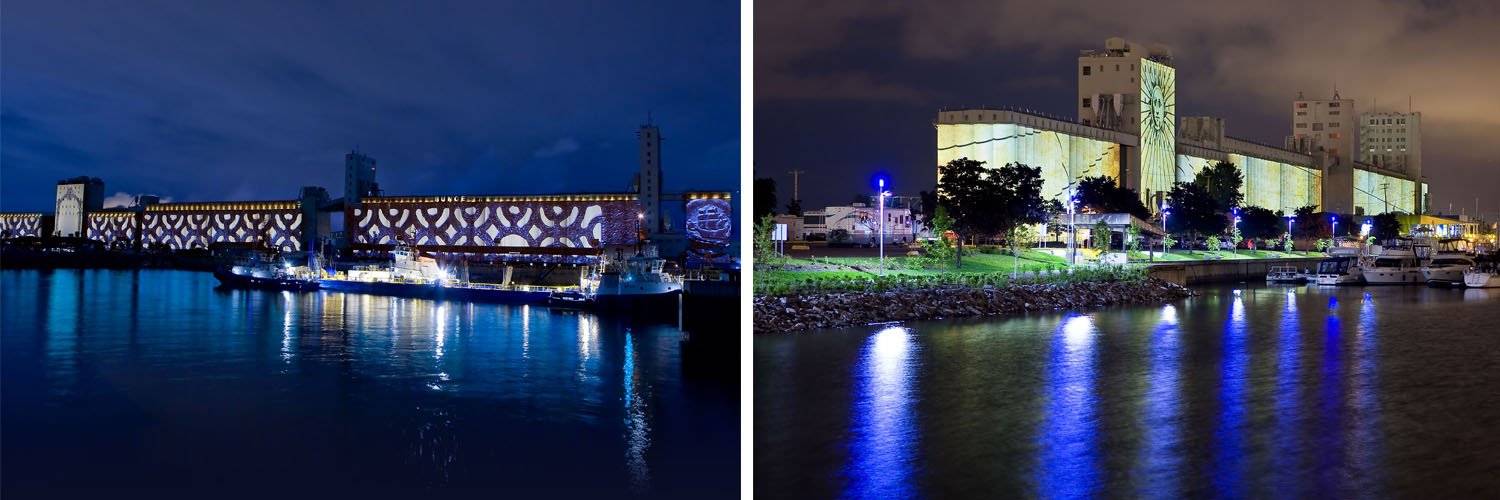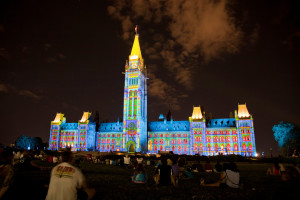Luminous Pathway
Originally conceived in 2006 to add excitement in Montreal’s Quartier des Spectacles, a district with 80 per cent of the city’s performance halls, the Luminous Pathway began with simple red dots shone onto sidewalks and has since grown to incorporate fully projection-mapped buildings, custom-illuminated intersections and ambient architectural lighting.
Today, with the municipal government’s support, climate-protected projectors of various sizes are permanently fixed onto buildings throughout the district, with more continuing to be added and made available to artists as public canvases.
“It has really caught on,” says Mikaël Charpin, deputy director of the not-for-profit Luminous Pathway partnership. “When building owners see projection mapping on someone else’s wall, they then want us to use their wall, too.”
“Every image must meet certain criteria before it’s considered for display,” says Ivan Klein, technical director. “Videos have to express the theme of the building they’re displayed on.”

In 2008, 81 grain silos along the St. Lawrence River were mapped and used as a giant screen to celebrate the 400th anniversary of Quebec City. Photos ©2007 Francis Vachon
The Image Mill
In 2008, 81 working grain silos along the St. Lawrence River were mapped and used as a giant screen to celebrate the 400th anniversary of Quebec City. Famed multimedia artist Robert Lepage created the Image Mill, a 40-minute spectacle, as an ode to his birthplace, which he called “the best-kept secret in North America.”
The Image Mill brought Quebec City’s story and culture to life on a 30 x 657-m (100 x 2,155-ft) canvas over 10 weeks. At the time, it was the largest projection surface ever created, earning a spot in the Guinness Book of World Records. The nightly showcase transformed the silos into rows of books, stained glass windows, a printing press, cigarettes, bullets and even other buildings, including a factory and an airport.
Lepage and his company, Ex Machina, took more than two years to plan and create the Image Mill, working with a French firm, ETC France. They needed 27 projectors to create a continuous image across the silos and around one side, along with kilometres of cabling for control and communications. Much of the planning was dedicated to accurately mapping images onto the uneven concrete contours of the silos and allowing for obstructions in the projection path like trees, buildings and electrical poles and wires.
The show was so popular, it was extended through the following five summers.

On summer nights from 2010 to 2014, the National Capital Commission (NCC) and Moment Factory projected the Mosaika light show onto the centre block of Ottawa’s Parliament Hill. Photo courtesy NCC
Mosaika
From 2010 through 2014, the centre block of Ottawa’s Parliament Hill was illuminated each summer with ‘Mosaika – Canada Through the Eyes of Its People,’ depicting the country’s history with a sound-and-light narrative.
Organized by the National Capital Commission (NCC) and designed by Montreal-based Moment Factory, the show projected video content across the 144-m (472-ft) wide building, including the 75-m (246-ft) tall Peace Tower.
“After Moment Factory did a full pixel mapping of the buildings, our biggest challenge was how to repeat the placement of the projectors to ensure a perfect performance every night,” says Jean-Marc Beauvalet, NCC’s manager of technical services. “The solution for the projectors that stayed on the hill was to place them on hydraulic lifts with repeatable heights. They have sensors that stop them at the exact position.”
The 2013 edition of Mosaika went on to top the digital signage category and win ‘best in show’ in Sign Media Canada’s 2014 National Sign Competition.





